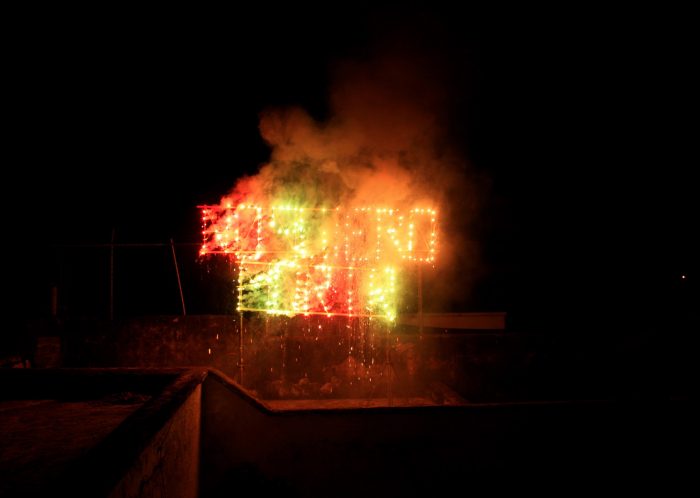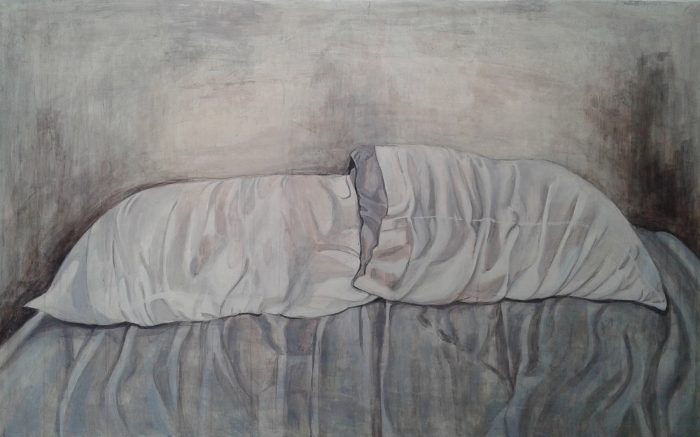Blog - Guadalajara Jalisco Mexico
Reading time: 7 minutes

24.06.2020
Espacio Cabeza / Bienal de Pintura José Atanasio Monroy, Guadalajara, Jalisco, Mexico
June 13, 2020



In Favor of the Spectral a curatorial project by Espacio Cabeza for Hecho en casa – Curatorial Program of the José Atanasio Monroy Painting Biennale. The curatorship goes over how the experience of the spectral opens itself in multiple ways in our contemporaneity by articulating different themes as disappearance, memory, imagination, visibility and invisibility, the future and the metaphysics of existence. As a curatorial text, Marco Valtierra, art historian and curator, discussed with philosopher Daniela Mesa Cardona.
I – Marco Valtierra: How should we think about the different experiences—fragmentary, invisible—of that which is called spectral? Or better yet, how should we face what seems to escape our eyes? When thinking about the idea, vague at some point, of curating “something” about the spectral, the questions that arose along the way remained as a personal concern. A restlessness to face the ghost, to recognize its fissures turned into deep cracks and stop running away from a dreadful silhouette. Only then I found out that spectrality is performative.
Meanwhile the questioning remained, how can we keep encouraging the conversation about contemporary aesthetics, outside the fringes of the dominant discourses, in order to reposition it in other horizons and territories, to promulgate new experiences of sensitive and affective contemplation?
II – Daniela Mesa Cardona: While influenced by their context and conditions, artists as subjects with agency have contributed with experiments in their field that have resulted in different ways of creating, understanding and connecting with works of art. We’ve already read countless times, and from different voices, the development that Aesthetics had–and which we all can empirically confirm either we are aware or not of the reasons—that the façade of art was torn down as a natural essence that can be dissected into specific properties.
So, what does the leitmotiv that tells us that any object can potentially be a work of art demonstrate? The face-to-face encounter with the spectrum. The weight of history and its deep inscription on memory. The relevance of agency and choices.
III – Marco Valtierra: Here we can ask about the singular, what experiences do the artworks gathered here lead us to? Political, emotional, memorial experiences or are they rather the range of possibilities and the overlay of each one of these experiences? As Helena Chávez Mac Gregor says, “as experience of sensibility (subjectivity) that burst in, stirring the discursive and visibility moments, like a force field that makes the aesthetic experience a revolutionary policy.”
The aesthetic experience and its different scenarios, in this exhibition, are subjected to a virtual spectrality, to a logic of tactile experience: to swipe, to see, to let go, or, with any luck, to react and share. Images are shared on a wall to disappear, being pushed into the time of oblivion, of things seen. But I insist on the way in which the past persists in the present and how it updates and goes around, makes itself. That which we have agreed to call “politics of memory”, affective memories that make subjectivities, emphasizing the places where these gain command and power. A stress must be put on the symptoms of the phantasmic: that which insists to be but isn’t.
While this exhibition starts from the idea of spectrality, its approach is not unidirectional, on the contrary, it tries to make appear different and multiple experiences surrounding the very phenomenon of contemporaneity; articulated around a force that links them at the same time it draws a correlative and causes them to overflow.
On the expectation of a time of dispossession, simultaneously and intimately linked to the time of disappearance, and following Jean-Louis Déotte: “[…] it seem evident to me that since World War II a community of sensibility has been constituted around a certain kind of affection linked to disappearance. We are a part of it. This cosmopolitical community is affected (and this is what its members share: an affection) by a silence that possesses a particular tonality.” How to continue existing, when only silence remains?
IV — Daniela Mesa Cardona: We know that Aesthetics appeared as an autonomous field during the eighteenth century and that since the crisis of modern culture (white and European) more and more in art and through art, we are having conversations about asymmetrical power dynamics. Which, of course, also talk about art as a field and as a normative and prescriptive institution. But that if we see in those marginal territories—which are not just a few—the so necessary questionings point to the ways of this Aesthetics in crisis that had delusions of universality.
That art got rid of the requirement of focusing only on the formal internal elements of the artwork—and that these had to be necessarily aesthetic—shows the participation of the subjects (many subjects) in historical dialectic processes. Knowing this was not a product of spontaneous generation opens the doors to understanding that this discipline does not have a lineal discourse, let alone a homogenous one.
And in the sensibility linked to disappearance, it is silence who questions us by facing us to the spectrality of art, of artists, and of ourselves. We know we must face our own history, reflect on the marks it has left in us, and come to terms with the consequences of our constant choices. These works lead us to initiate a conversation about the past and the memory of art that is made in our present, but also about the place in which these works are being inscribed in it, in us and in virtuality. How do new ways of exhibiting art influence our cognitive, emotional and physiological responses to works of art?
V— Marco Valtierra: Above all, what position does the body take in these new modes? Modes that haunt us for a long time. Let us not forget, our time is the time of dispossession. And in this framework, where everything seems to open up and new laws appear in the narratives about the sensible experience, how to name that whose logic is non-existence?
VI— Daniela Mesa Cardona: By making a conversation from diverse and distinct experiences possible and acknowledging the cracks of the past and their effect. The work of art, by the artist’s choice and action, questions and challenges established history for trying to standardize it. In the words of Miguel Ángel Hernández Navarro, art is making history: “[…] as the writing of time with aspirations of truth and justice” and memory “[…] as the fundamental object that goes through it and makes the past affect the present” (p.31).
And it is quite right that by choice these questionings start conversations that generate works that aim to subvert these dominant policies of the past. Let aesthetics never go back to functionalism, just as we do not go back to the mere contemplative attention of the work of art.
VII— Marco Valtierra: The specters we carry on our shoulders will have to be invoked, which hold a significant place in memory, in our affections, in our conscience. This is about conjuring the specters, not to exorcize them but to recognize the crevice they inhabit today.
VII— Daniela Mesa Cardona: The silence that does not question, besides insolent, is unforgivable, especially because we see and hear the never-ending specters with which we live day by day. Where do we want them to live today and tomorrow?
IX— Marco Valtierra: Perhaps the specter is not always hidden. Today more than ever it is present, and its presence is felt in multiple ways. The specter and its performativity, though an event of the past, gains power only through its future condition.
For the time being, this conversation will remain pending…
—
Espacio Cabeza is a nomadic, nonprofit and self-managed platform dedicated to contemporary art exhibition, founded by artist Juan Carlos Guerrerosantos. The exhibition schedule seeks to contribute to the panorama, discussion and cultural promotion of the current artistic practices.
—
Daniela Mesa Cardona (Armenia, 1995) is editor, writer and Aesthetics and Philosophy of Art researcher. Licensed on Philosophy and Literature by Universidad de Caldas (Colombia), with a Master’s degree on Philosophy by Universidad Nacional Autónoma de México (UNAM), an academic exchange on the History of Art program of Universidad de Guadalajara (México), and with an research fellowship as Visiting Research Fellow at the Centre for Aesthetics of University of Leeds (United Kingdom).
—
Marco Valtierra (Guadalajara, 1994) graduated on History of Art by Universidad de Guadalajara. He is currently curator at Espacio Cabeza and founder and co-director of Laboratorio Curatorial Archipiélago. In 2019 he worked as education assistant at Museo de las Artes de la Universidad de Guadalajara (MUSA). He has written papers for colloquiums and academic encounters of institutions as Universidad de Guadalajara, Universidad de Guanajuato and ENES Morelia (UNAM).
Special thanks to Al revés Traductores for the English translation of this curatorial text.
—
Exhibition available at https://www.facebook.com/bienaljamonroy/
https://www.instagram.com/espaciocabeza/
Comments
There are no coments available.